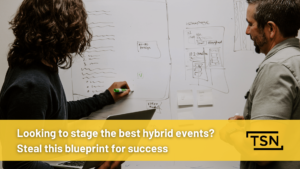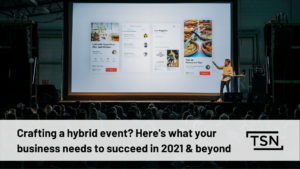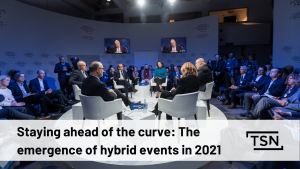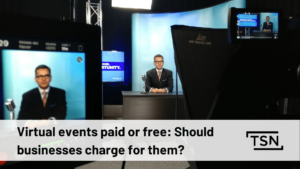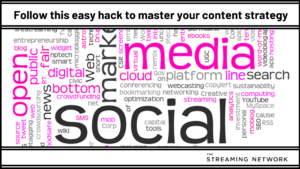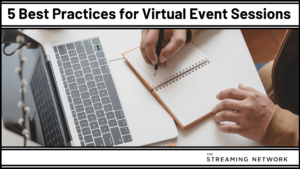Podcast: Play in new window | Download | Embed
Subscribe: Apple Podcasts | Google Podcasts | RSS
Lessons From The Frontline
In our last episode, we went in depth on the importance and application of repurposing webinar content.
This week, Peter and I are going to take it a step further. We will discuss why you should be personalizing your webinar content.
Part of the discussion will touch upon persona-based marketing – creating and curating content for different personas. Also, we take a moment to revisit at a popular webinar marketing strategy leveraged by many B2B companies, Account-Based Marketing.
Our episode will go into the many factors of webinar personalization, such as getting the right content in front of the right people and how to do it.
We will be tackling the following topics:
- Why is personalization important in webinar creation?: Marketing automation is an effective tool – but sometimes customers need a human touch.
- What are the key aspects of webinar personalization?: We have learned that eventually, you will have different types of buyers at different points in the buyer’s journey. What does that mean for you?
- How exactly does personalization fit in a webinar strategy?: The more personal you get – the better your webinar will perform.
The Complete Video Transcript
Pete: Hello, welcome to LFTF, Lessons from the Frontline. With me as usual is Matthew Ley, President of The Streaming Network. As you can see today, we are here in beautiful Mexico, enjoying a lovely pixelated–
Matt: Pixelated view of the beach.
Pete: Nothing–which sort of, because we’re talking about such digital subjects as personalization, I think a pixelated view is somehow appropriate.
We’re going to talk a little bit about personalization, or a lot about personalization.
Google and Facebook, along with so many other businesses, are really into personalization.
This is, like, front and center in terms of engaging their audiences, but there’s also a way to apply this when you’re creating a webinar, and so we want to dig a little bit into that and talk about how you can take your webinar or program and create a–layer personalization onto it.
So, let’s start, why don’t we just start talking a little bit about why are people talking about personalization?
What’s going on right now in the world today that this has kind of become an interesting and worthwhile subject?
Matt: Well, I think–well, I think there’s a couple different things, is that I think it’s a bit of a backlash, is that we all–we still talk about the importance of our automation programs, because they are important and automation–there’s automation involved in personalization too.
But, things got a little too automated, and we’ve all been stuck in an automation that we didn’t want to be a part of and we forgot to opt out of or whatever it might be.
And, we’ve all delivered automations that have not been very good and what not, so there’s an automation–marketing automation that is part of what got us here and is very important, but it lacks the personal aspects.
And, we’re seeing it across the digital spectrum, whether it be the need to have tickets responded to you by humans, not by auto responders, to, in this case, trying to get more human in your engagement and more personal in your engagement.
But, on the flipside, you referenced two big companies, huge companies, who have been collecting scary amounts of data on us for the last ten years, and as a result of having all of this data, Google, Facebook, are able to put a lot of ads and a lot of information in front of us that is very unique to us.
Now, when you and me search the web or when we’re on the web, it’s a completely different experience from one another, and that’s because of the way they personalize our overall experience.
And, so the world of B2B is starting to–not starting to, I mean they’ve been doing it for a while, we call it persona based marketing where we were creating and curating content for different personas.
And, with the advent of account based marketing, which is a massive trend and in B2B, especially if you’re in enterprise sale, it’s more effective, important, and more money is going into it than any inbound strategy whatsoever, is that account based marketing is all about that personalization approach.
So, it’s–I would probably say the thing we hear the most out there is about it and it’s also that thing, I call it three or four years ago when we would ask about someone’s social strategy and they would smile and say, “We’ve kind of got one,” or “We’re working on one.”
People know it’s something that they should be doing, the personalization of content, but they’re not quite there yet.
Pete: They haven’t quite defined exactly what it means.
When you’re personalizing, and in this case, clearly even when Google and Facebook does it, they’re just taking content that’s already been created, and reams of the content that’s already been created, and then filtering it to people that are going to be engaged in that content.
But, they’re not creating it, but they’re taking content that’s created.
Matt: Yeah, all they’re doing is they’re looking at who you are and people that look like you, and actually they’re not even doing it in many cases with ads.
All they’re doing is providing that data to people like us who advertise and we decide we want to be in front of (unintelligible).
But, all they’re doing is they’re displaying the content they think–they’re either displaying the content they want you to see or they’re displaying the content that they think you should be seeing, and that’s what–that’s one aspect of personalization.
So, on the last podcast, we talked about the repurposing of content, and we talked about different buyers and what they–how they consume content.
And, if we knew exactly who it was that was coming to our website, how old they were, what their level–what their job was or what their level was within an organization and all that, and we could only give them the content that we thought that they were going to–that they would like to consume, then things would be really awesome for us.
We don’t have that ability or that capacity, but that’s part of it is getting the right content in front of the right people; that’s one aspect of personalization.
Another aspect of personalization that comes along with this is based around people’s known interests.
So, we know certain people have certain interests that are different from others, based around how they’ve interacted with our past content, the webinars that they’ve attended, the–what they’ve read on our website.
What we can track, we kind of know, and as a result, we can start suggesting certain pieces of content to them.
And, usually when we’re suggesting, we’re suggesting stuff that we think that they’ll like, like what YouTube does when you play a video, but often, we’re suggesting to them something that will help move them to the next stage.
You’ve watched this five minute video on webinar ROI, now watch this webinar on the subject, it’s 45 minutes and it’s going to give you everything you need to know.
Once you go through that, and if you watch the whole thing, I’m pretty sure you’re ready for the next stage, which is engagement with one of my sales reps.
Pete: So, now as we enter into breaking this down in terms of the world of webinars, is personalization–where does it fit in to, even if we’re talking about the funnel?
Is personalization something you do further down or is it kind of all over the place?
How does personalization work within webinars?
Matt: Well, there is a webinar strategy, I think, clearly because I love webinars, that can be applied to every stage of the buyer’s journey, and we had a podcast planned for that in the future.
But, so the more personal you can get at all stages, the better you’re going to do.
So, what that might look like is, like most companies, we service a diverse group of companies.
So, we have a financial services practice, which everyone who listens to podcasts has heard about.
We service the legal industry and the accounting industry, but they’re very similar in how they utilize the tool, technology, life sciences and pharmaceuticals, and each of them live and operate in a slightly different world, and webinars have a slightly different value proposition.
But, when you get down to why they should use ours and not the other guys, a lot of times they relate back to the same core values of the data, the engagement, how we benchmark the users and how we integrate into existing systems and how we can help them pull the gold out of who’s been through their program.
So, but because they all have different terminology, because they all–one calls them a client, one calls them a customer, one calls them a prospect, one calls them whatever it might be, is that by creating content that is specific to–is personalized to that organi–or that vertical, you have a better chance of attracting that lead at the front end.
And, anyone who’s ever done verticalization of collateral knows, that has a lot of the same stuff with a couple different logos and a few different words sort of mixed in.
So, at the top line, that’s where it is, but you brought up a point that was very, very important, is that many people out there have a webinar program that looks like this.
We have a calendar and we are going to do these webinars and we are going to invite our list to said webinar, but that’s not what the larger, more evolved organizations are doing.
So, when you look at someone like Microsoft, who two years ago were doing–or three years ago maybe, I’m not sure when this case study started, but doing 200 webinars a year is now doing 4,000 to 5,000 webinars a year, or live webinars a year.
Now, they’re not producing 5,000 webinars a year, and we’ve been talking about this for years.
What they’re doing is, based on the data that they know about their pipeline and where people are, is they are not sending out anything to their entire list, is they are promoting the right webinar at the right time.
Marketers have known this for a long time and those who have integrated their tool and have drawn straight lines between webinar data and revenue, or pipeline, know this even better, is that if someone goes through a webinar, they’re ready to take the next step.
That next step may be a purchase or a talk with a sales person, it may not, it may be a demo; it all depends on where they are at the point in time.
So, if you’re looking at your pipeline and you see that you’ve got this many people in consideration on this product, then you want to be promoting certain webinars to them.
And, this idea around simulated live, the ability to take webinar content, promote it to a group of people and have them interact with it, is something that is being done at the larger organizations a lot, so that they’re personalizing that person’s buyer’s journey if you will and trying to get that in front of them.
They’re also trying to get other things in front of them at that time, white papers, e-books.
Different things are coming at them at that time, the webinar is just one, because they know if the person gets through that, they’re more likely to become a purchasers or they’re more likely to take the next step, right?
So, they’re personalizing when you hear what message, rather than trying to do one message for everyone.
Pete: So, these are webinars that were created previously, you know that there’s a group over here that’s interested in that, and you act–you simulate it as if it’s a live event, go through the entire process as if–like the first time you did it, and you just keep doing this, and each new group, you’re personalizing this content to them because you know that this is the sort of thing that they want.
But, you’re actually never creating–or in these instances, you don’t even necessarily have to create new content.
You’re putting old content out there as if it’s new.
MattL Right, and it’s a little bit–I just want to make sure that we’re on the same page with the wording here.
It’s a little bit what they want and it’s a little bit what you want them to see.
So, the person is in a consideration stage of the journey, you’re going to want them to consume certain content that you know gets them past that point with you, and so you want to put the content in front of them that makes sense to you, not just the stuff that they like or they do enjoy.
Pete: You’re still trying to sell something.
Matt: Yeah, exactly, and because the webinar is such a key indicator of readiness to take action, that’s where the people like the Microsofts’ or those who have these really evolved programs is why they’re doubling down and they’ve got 4,000 running in the course of the year, is that they are everywhere.
Even in the post-sale, they’ve got these running to the right people, smaller audience sizes, because they feel they have a greater impact, and the simple fact that you decide not to participate in that webinar, live or on-demand or check out tells them something, too.
You’re lacking–you’re not ready to take that next step, something’s going on.
Pete: That’s really interesting. That’s great, those numbers from Microsoft are phenomenal.
That’s an unbelievable growth in terms of their overall webinar.
Let’s talk a little bit about on demand; how does that fit into all this?
Matt: Very similar to how it fits with the live.
So, on demand, every data point for on demand is growing rapidly.
The number–people often–even today, I was having a conversation with a gentleman who was in here and we were doing a webinar this morning and he was like, “Yeah, but I mean, on-demand, that’s like that thing you TiVo that you mean to watch that you’re never going to watch.”
Okay, there’s a lot of people who don’t, there’s a lot of people who still register and never show up to a webinar at all, which is why we suggest running webinars over and over again live, because there’s a psychological advantage to it.
But, every part of the on-demand data set is rising, how long people view, number of total audience members who participate in on-demand.
Every year, we’re seeing this number go up. We’re well over 30 minutes for on-demand now on webinars.
And, I think that has to do with our on-demand culture, Netflix, all of our content, we want it when we want it and we’re used to doing it that way, so we will actually go seek out and consume it that way.
And, probably has a little bit to do with how well some really smart marketers are at customizing our experiences.
So, one thing that in the ABM space, there’s a lot of tools out there that will create what are called content experiences, and that content experience beyond being tailored to, say, financial services or technology, it will be tailored towards your company.
You will be sent–you’ll enter into an automation or be sent an email or be–or click on something, and all of the sudden your company’s logo is up there beside the person who’s marketing to you.
And, the content choices that are in there are based around the stuff that has had interest or more importantly, the data on what you are looking at as an organization.
So, with embedded within those content experiences are webinars, because the same thing about watching that live is that they’re going to spend 30 minutes, on average, or over 30 minutes now, on average, with a piece of content.
That is a vested individual, that is someone who’s really taking a good look at you in an organization, and if you are going–and usually again, this is enterprise stuff when you’re doing this.
But, if you’re going to be targeting this company and you want to move them into that next step, you–that’s a person that needs to be talked to or spoken to or whatever it might be.
So, webinars are a big part of most people’s ABM strategies and they’re called, they’re persona-based marketing initiatives that they have out there, personalization.
Pete: And, there’s on risk in terms or recycling and repurposing content, because each one of these groups, you know who they are.
No one else is going to–so you can kind of, ad nauseam, repurpose stuff as long as you’re targeting, right?
Matt: I mean, yeah, and I mean, you’re never not, you know what I mean?
When you started this journey with me, I don’t know when our last webinar–or our first podcast was, do you remember how long ago that was? Was that almost a year now?
Pete: Yeah, almost a year.
MattL There’s stuff I said that day that you didn’t understand, right? You were just getting into this.
You actually googled stuff on webinars before talking to me the first time, right?
Pete: Yeah.
Matt: And, so–
Pete:–Don’t kid yourself, I still don’t understand.
Matt: Well, you’re doing a lot better.
Pete:Thank you, I’ve learned how to fake it.
Matt: I heard you talking about that person, you’re like, “Yeah, and this and that and the other.”
I was very proud of you when you told me about that (unintelligible).
Pete: No, no, I have a much clearer understanding of this whole thing.
Matt: But, there are aspects from that first one, I’m sure if you went back and actually listened to it without being able to critique the performance of us or whatever at the time, that you would be like, “Oh, I see, I get that now,” right?
Pete: Right.
Mata: And, so I mean, some people are like, “Oh, you’ve got to refresh that.”
It’s–we have a financial services webinar, it was shot in 2015, and it does look dated.
It looks dated, our set’s dated, our colors are dated, it looks dated, but the content is spot on.
So, if you’re out there and you’re looking to start a professional–a financial services webinar program, like you’re starting from scratch and you want to know what other people do and how to build something to be–to move into that thing, this is the blueprint.
Pete: It still works.
Matt: It still works. Nothing has changed. Why do I take–why should I take it down?
And, if someone didn’t watch it when they were at a place that had an existing webinar program, they go somewhere else, they’re asked to start it and they’re like, “Oh crap, I didn’t start it last time, I need to know how to start it,” they go there, they’ll learn how to do it.
It’s a good piece of content, for the right person, at the right time.
Pete: A lot of the stuff we’ve been talking about here has been focused on larger enterprise sized organizations, but a lot of our clients are smaller operators.
Is this stuff that you’re talking about, does this only work for bigger companies or does this also apply to smaller operators?
Matt: I think trends are trends and there’s a reason why everyone is talking about personalization, and if you’re small or large, you should be doing it, let’s just be honest.
If you don’t have the right technology stack, it’s going to be hard to do, and if you–and so for smaller companies, it’s going to be even more challenging.
There are a lot of technologies out there that help do it, that make it really smart and intelligent and enable the entire process, but personalization is something that everyone should be doing, for the same reason that webinars work for everyone.
So, we throw out the HubSpots’, the Hootsuite, the Microsoft stories because these stories are so–like, the numbers that are tossed around of viewership, pipeline, number of webinars, change in position.
I mean it was Microsoft, they were only doing 200, now they’re doing 4,000 a couple years after working with the platform.
But, everything that holds true for them generally holds true for everybody else; the question is how can you do it?
So, I like to juxtaposition two deals we were working on at the exact same time, that closed at the exact same time, and before I jumped on a plane to go out to Vancouver to speak with Hootsuite, who gets, on certain webinars, they get 10,000 registrants and they get thousands of viewers and they require a way of segmenting the best viewers.
And, their sales team does not want to follow up with everyone because they know there’s a lot of people there that are just there to learn and are not buyers.
So, they had to find a way of skimming off the top of the webinar viewership, the people who were most ready to buy and in doing so, they had to utilize a lot of the engagement metrics that we talk about over and over and over again.
Well, at the same time, we had someone sitting in the studio who I came down to shake hands with because it was a company called Tucker Professional Corporation, and Tucker Professional Corporation is an accounting firm and I use the term firm because that’s what they are, but it’s one accountant with some people that do–that maybe they’re CGAs, maybe they’re pre-CAs.
But, it’s one guy, basically.
Pete: Tucker.
Matt: Tucker, it’s his professional corporation and he has got a business where he does the books for doctors or a medical practitioners.
And, he was in here doing the studio gig and he was doing the webinar program and it was interesting because it was a much smaller–much smaller than a Hootsuite, it’s one guy.
Pete: And, unexpected. I mean, you don’t get a lot of one person shops doing these sorts of things, right?
Matt: Right.
Pete: That’s quite unexpected.
Matt: So, what happened was is that for him, it was, he had been doing webinars, just like Hootsuite, for a couple years.
He had been doing the same webinar; it’s a webinar he does for medical grads who, I found out on that day, go from making $60,000 a year to making $280,000 a year.
They’re in tons, tremendous amounts of debt, and the CRA makes it not that easy for them to get all their tax credits while they’re in school and losing money at an alarming rate and racking up that debt.
And, so what he does is he just says, “Look, here’s all the things you need to be doing and if you want to send your stuff in, I’ll do it for you for free,” and the idea is that he does it for free and then when they become a doctor and they’re making that money, they become a customer, client.
So, he would do webinars in the past but he would do a follow up, but he didn’t know anything about anyone, he didn’t know what it was.
He basically knew he was getting clients out of it but had no way of prioritizing who he followed up with, because he’s got billable hours.
He’s not a sales person, he’s not going to beg for business, so he’d do a follow up email and see what happened.
He always had a couple customers, so he always did it.
So, he goes from doing that on what I think was even a free service or something like that that he was using, to coming in here with all of this and hosts and whatever, because he figures he can use it every year for a while until the laws drastically change, and with the same data that enabled Hootsuite enabled him to be able to know who to follow up with.
So, in his case, he’s utilizing this asset on-demand, which is highly–I mean, he’s got a highly focused business, but highly focused and personalized to somebody who has not yet graduated from med school, who’s racking up debt, and offering to do their books for them.
This is a tool that, we asked him the other day why he hasn’t been back and he’s like, “Well, I keep using it.”
Pete: Because it keeps working.
Matt: It keeps working. There’s not a need right now for him and his business to even create another piece of content.
So, I mean, I’m not going to say–I think he has a personalized business if that makes sense, but it does speak to the fact that it works for everyone, large or small.
Well, let’s look at us, we’re about a $10 million business, but we’re servicing very, very, very large customers, and we have a very, very different message for that financial services, that law firm, that tech company.
We have even different services; the law firms do a lot of our professional services where the tech companies don’t even touch them, they do it all themselves.
And, so talking about our studio and talking about this and talking about that, they don’t even think we’re a webinar company; they think we’re something completely different.
So, in the old days where we had the one website, one experience, one this, one that, we had to drive–hope they drove them to the right spot and they were looking for the right thing.
So, we started implementing the base minimum of personalization, which is these idea around the persona of who the person is and what the organization looks like, and a little bit of ABM strategy so that we can get all the great content that we’re doing, but the right content in front of people.
So, we’re utilizing a tool, it’s called Target, and it allows us to create these content experiences that we’re putting out and tracking how different companies are interacting with us, and I think it’s going to be a big way that we go.
And, part of the impetus for us and investing in it is that we are dealing with those large organizations, where there’s multiple buyers and it makes sense.
So, I think that it’s important for everyone to get as personal as possible with their marketing, it’s important to know the–we all know that different buyers and different verticals and different buyers and different levels look at different things.
Watch our repurposing–or listen to our repurposing podcast on ideas on how to do it once and have it work for everyone, but yeah, I don’t think that this is limited to the enterprise, by any stretch of the imagination.
Pete: Great. So, we–at the beginning of this podcast, just before we went on air, I said to Matt, “I think we’re going to get through this entire thing in 20 minutes.” We’ve made it through two questions.
So, I’m going to call it now, I’m going to say thank you very much to those in the audience that are watching, I’m going to say thank you to Matt.
Matt: Yeah.
Pete: We’re going to do part two of this and it’ll be a really great one to punch.
We’re going to dig a little bit deeper into personalization and how it actually works and some examples of–we’ll ask some big questions, we’ll ask some small questions.
So, until then, that’s the world of webinars as we see it.
Matthew Ley, thank you very much.
Matt: Thanks, Pete.
Pete: We’ll see you again.

